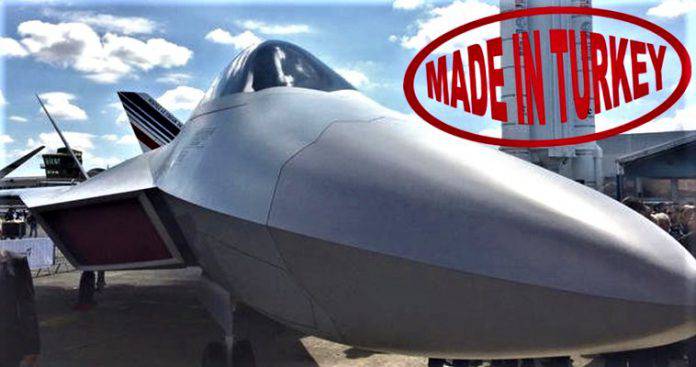Kostas Melas: The made in Turkey TF-X fighter is just a pipe dream
11/11/2020
The inability of the Turkish industry to produce engines capable of being installed in modern weapons systems is also evident in the case of the attempt to build the TF-X fighter jet, entirely in Turkey. Turkey, after being excluded from the production program of F-35 American-made fighter jets, is facing a serious problem that has two sides.
The first is the aging of the F-16 fleet that will occur during the current decade and makes the need for its renewal urgent. The second aspect concerns the fact that a number of neighboring countries, with which it is in conflict, will acquire F-35s by the 2020s. Apart from Israel, it has been agreed, with the consent of Israel, that the F-35 be sold to the Gulf monarchies, first to the United Arab Emirates and then to Saudi Arabia.
Egypt will obviously follow in the US effort to stabilize its presence in the region. In fact, there are reports that talks are underway with Qatar as part of the US plan to cut off its influence from Iran and the Muslim Brotherhood. If that happens, Turkey’s difficulties will increase, as the Gulf state is Erdogan’s main financier. No one anticipates that this will happen, but in international politics, no one knows the developments that are directly related to the interests of each country.
We do not know at the moment what are the thoughts of the Greek government especially after the purchase of the French Rafale, which largely cover the needs of the country. At the same time, with the acquisition of Rafale, Greece, already in 2021, acquires a strategic advantage, which Turkey does not have the ability to overturn, at least for the next five years. This advantage gives Greece the opportunity to decide whether to join the F-35 club or the European 6th generation fighter jointly being developed by France and Germany.
Turkey has been excluded from the F-35 program, but is making efforts to return. Many analysts believe that it can achieve it. However, the geopolitical developments that have taken place since the signing of the “Abraham Agreement” make this effort extremely difficult. The opening of the door of Washington to the Gulf monarchies, which is expected to be sealed with the signing of a corresponding agreement between Saudi Arabia and Israel, closes this door to Turkey. Saudi Arabia and the UAE, Turkey’s strongly vehement rivals in the Middle East and North Africa, will not allow much room for maneuver for Ankara, within the US halls of power.
Is the TF-X the solution?
Dealing with this problem is very difficult for Turkey. Even the thought of buying Russian MiG-35 or Su-57 aircraft would bring not only the wrath of the US to bear but clearly something more. Apart from the fact that Russia does not seem willing to make such a sale in the current circumstances. According to reports, during Erdogan’s recent visit to Russia, the issue was discussed with Putin, but to no avail.
In the face of this impasse, Erdogan’s Turkey has found a way to speed up the production program of the Turkish TF-X fighter jet to replace the corresponding F-16s in the 2030s. This is an ambitious program that began in December 2010. The whole design is an attempt that bears a striking resemblance to the American F-35.
Apart from the many problems, the main and basic problem is the engine that will be used to power the fighter. From May 2017 to March 2019 there was a partnership with Rolls-Royce to build an engine similar to the Eurojet EJ200 used in Eurofighter Typhoon fighters and based on XG-40 technology developed by the British company since the 1980s. Rolls-Royce withdrew from the program in March 2019, creating a major problem in the continuation of the project.
Following the departure of Rolls-Royce, the Turkish company Aerospace Industries sought a solution through the Russian RD-33 engines used in Russian MiG-35 fighters. But even this effort did not bear fruit. So Turkey decided to build its own engine that will be ready in 2029. Difficult decisions with little hope of success without the decisive help of foreign technology.
The first Muslim fighter jet
Given these problems, “the first Muslim fighter jet” (the phrase belongs to the CEO of the Turkish company Aerospace Industries, Temel Kotil) will probably be too late if it is ever produced. Because technology is advancing too fast and makes programs that can not keep up with it obsolete.
The conclusion could be that there is a stalemate concerning Turkey’s airpower. Has Turkey finally fallen into a trap that it has built with its own policy? Developments will show. However, it takes a lot of audacity to point fingers threateningly and raise your voice against those countries on which you are technologically dependent to such an extent that if you are abandoned you will not even be able to produce car tires.
It is clear that the incorporated (copied or stolen) technology is not at such a level as to allow Turkey to boast of being a major economic power. The progress that has been made in recent years is based on low and medium technologies that usually the most technologically advanced countries give, without particular problems, to countries with a lower-tech level. When you struggle tooth and nail to build an airplane engine in the next 10 years, something that developed countries have achieved since the second decade of the 20th century, it is difficult to convince of your financial strength. Simple and clear words.





